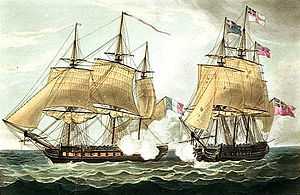French frigate Clorinde (1808)
 Clorinde fighting HMS Eurotas | |
| Career (France) | |
|---|---|
| Name: | Clorinde |
| Namesake: | Clorinda |
| Laid down: | 19 July 1806 |
| Launched: | 1808 |
| Captured: | 26 February 1814 |
| Career (Great Britain) | |
| Name: | Aurora |
| Acquired: | 26 February 1814 |
| Fate: | Broken up on 24 April 1851 |
| General characteristics | |
| Class and type: | Pallas-class frigate |
| Displacement: | 1080 tonnes |
| Length: | 46.93 metres (154.0 ft) |
| Beam: | 11.91 metres (39.1 ft) |
| Draught: | 5.9 metres (19 ft) |
| Propulsion: | 1950 m² of Sail |
| Complement: | 326 |
| Armament: | Nominally 40 guns In practice carried either 44 or 46 guns:
|
| Armour: | Timber |
The Clorinde was a 40-gun Pallas-class frigate of the French Navy, designed by Sané.
From June 1809, she was stationed with the 16-gun Milan and the 38-gun Renommée. In September, she sailed with Renommée, Loire and Seine to Guadeloupe. On 13 December, she and Renommée captured HMS Junon.[1]
On 15 December 1809, she ran aground, and freed herself by dropping guns and ammunition overboard.
She took part in the Action of 20 May 1811, fought off Madagascar, and returned to Brest. Captain Jacques Saint-Cricq was found guilty of failing to properly support his commodore, and demoted of rank, expelled from the Legion of Honour, and sentenced to three years in prison.
On 25 February 1814, at 47°40′N 9°30′W / 47.667°N 9.500°W, and under Commander René Joseph Marie Denis-Lagarde,[2] she was chased by the 38-gun HMS Eurotas.[3] A violent fight ensued for two hours and 20 minutes that left both ships dismasted, Eurotas suffering 20 killed and 30 wounded (including Captain John Phillimore), and Clorinde, 40 killed and 80 wounded. During the night, the ships built jury rigs and resumed the pursuit the next day, when HMS Dryad and HMS Achates intervened. The helpless Clorinde struck after the first cannon shot from Dryad, who towed her to Portsmouth.
Clorinde was brought into British service as HMS Aurora.[4] She served off South America from 1821-25[5] and in the Caribbean from 1826-28.[6]
From January 1832, she was used as a coal depot in Falmouth, and was eventually broken up in May 1851.
Notes, citations, and references
- Notes
- Citations
- ↑ HMS Junon, naval database
- ↑ Notice Biographique, René Joseph Marie Denis-Lagarde
- ↑ HMS Eurotas, Naval database
- ↑ HMS Aurora, Naval database
- ↑ A Frigate of King George, Brian Vale, 2001
- ↑ http://www.pbenyon.plus.com/18-1900/A/00403.html
- References